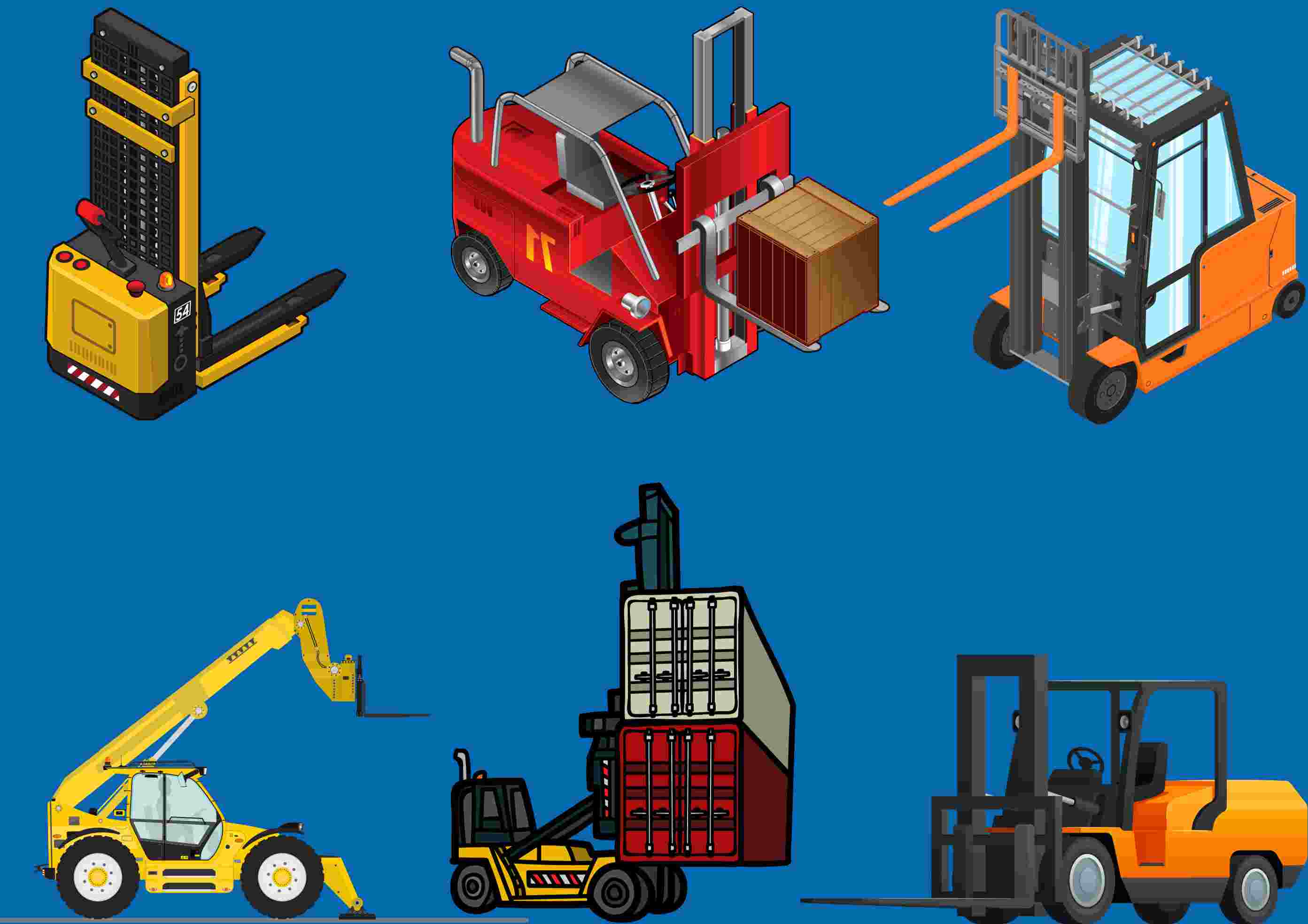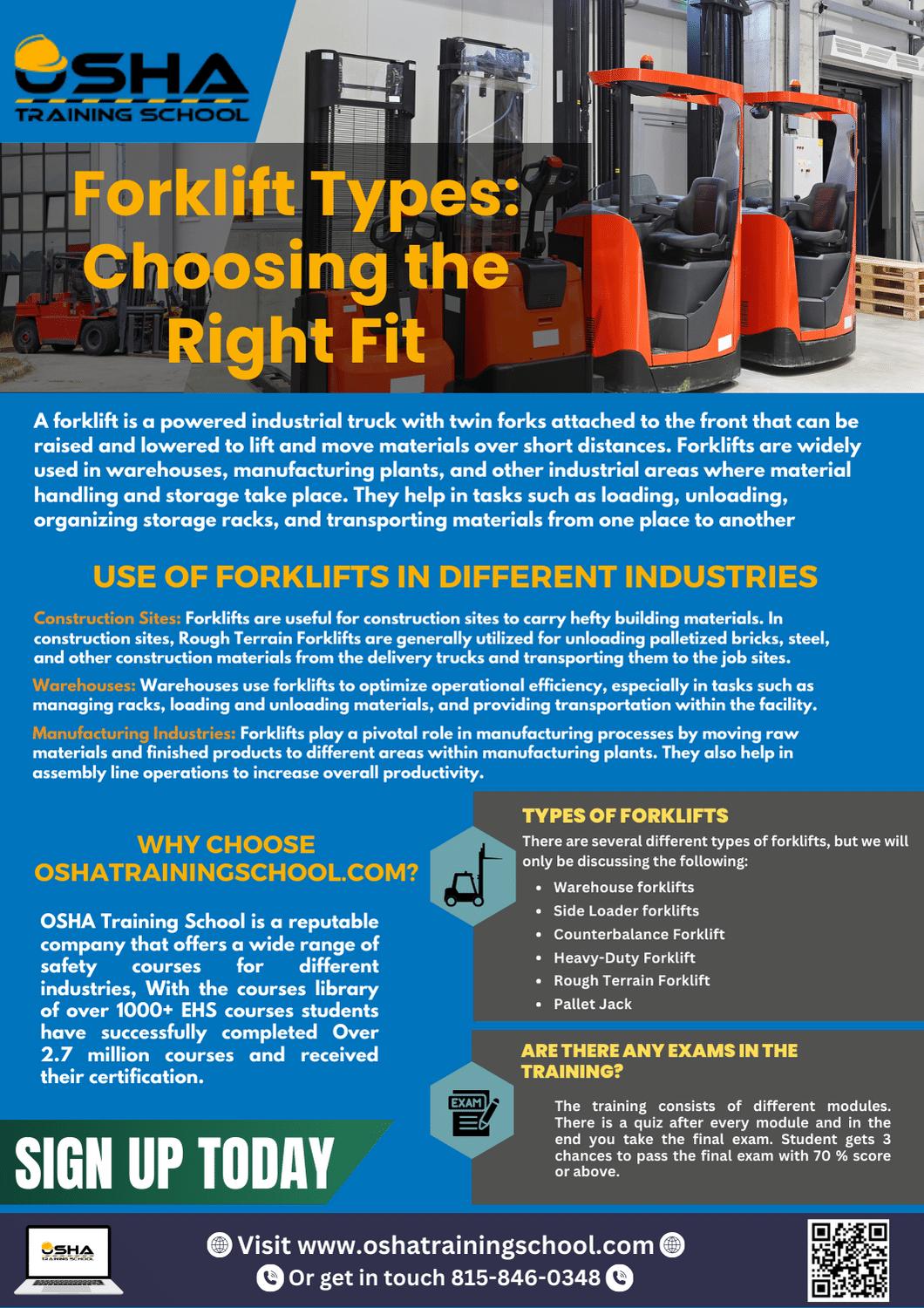
Online OSHA 30 Training in Connecticut for Workers and Supervisors
OSHA 30 training has become an important qualification for workers and supervisors across Connecticut...


A forklift is a powered industrial truck with twin forks attached to the front that can be raised and lowered to lift and move materials over short distances. Forklifts are widely used in warehouses, manufacturing plants, and other industrial areas where material handling and storage take place. Forklifts are useful for competently moving heavy and bulky loads within a facility. They help in tasks such as loading, unloading, organizing storage racks, and transporting materials from one place to another. A forklift is also known as a lift truck and fork truck.
Certain forklifts allow operators to stay seated while driving and operating a lift truck; these are called sit-down forklifts. While the others, require operators to stand during operations and are known as stand-up forklifts.
Sit-Down Forklifts: Sit-down forklifts are available in both three-wheel and four-wheel varieties. In confined spaces choosing a three-wheel forklift can be the right choice. Operators who spend more time on forklifts and do not need to dismount to handle materials may find sit-down forklifts to be the right ones for the job.
Stand-Up Forklifts: Stand-up forklifts are used by operators who often need to get on and off the fork truck. These forktrucks can easily maneuver in small spaces due to their compact design. The operators of these forklifts benefit from improved visibility in all directions and can avoid the need to turn their necks while standing sideways.

| Sit-Down Forklift | Stand-Up Forklift |
|---|---|
| A sit-down forklift is equipped with a seat, providing greater comfort to the operator. But it may have blind spots, particularly when reversing. Operators may need to stand sideways to avoid uncomfortable positions and have better visibility. However, standing is generally less comfortable than sitting. | Operators may need to stand sideways to avoid uncomfortable positions and have better visibility. However, standing is generally less comfortable than sitting. |
| This forklift is designed to handle immediate stops and reduces the risk of slips. | The maneuverability of stand-up forklifts makes them perfect for small spaces and tight aisles. |
There are several different types of forklifts, but we will only be discussing the following:
Wearhouse Forklifts: These forklifts can handle substantial loads and are generally utilized in warehouse facilities to handle and transfer palletized goods, as well as transporting materials over short distances.
Side Loaders: These are stand-up forklifts. They are commonly used by operators in the steel manufacturing industry. Side loaders can carry heavy loads of large items, such as steel beams and pipes. Due to their sideways operation and the direction towards the load side, operators eliminate the need to turn their necks, resulting in an improved view and making side loaders suitable for maneuvering tight aisles.
Counterbalance Forklift: Counterbalance forklifts are designed with the weight at the rear of the lift truck to balance the load being lifted at the front. This ensures the balance and allows the truck to navigate and handle loads without requiring additional support in the front. These forklifts are specifically crafted to operate in compact areas and provide great value in warehouses and manufacturing facilities where 360-degree movement is important.
Heavy-Duty Forklift: The functionalities of these forklifts are similar to warehouse forklifts. However, they possess the capability to lift much higher loads compared to standard warehouse forklifts. It can be perfect for industries that deal with heavy products, such as construction sites where the routine handling of heavy materials is necessary for daily operations.
Rough Terrain Forklift: These forklifts are also known as straight mast forklifts and are specifically designed to move materials over unstable surfaces. Primarily for outdoor use rather than indoor. Their tires also differ from those used indoors to prevent damage from sharp materials and give better balance and stability for safe operation on hilly and rocky terrain.
Pallet Jack: Pallet jacks are mostly used in warehouses that have tight spaces and limited loads, pallet jacks are ideal for handling and transporting materials from one place to another. These forklifts are also called pump trucks.
Forklifts are for multiple industrial purposes and their versatility makes them necessary in various industries. There are some common industrial uses of forklifts:
Construction Sites: Forklifts are useful for construction sites to carry hefty building materials. In construction sites, Rough Terrain Forklifts are generally utilized for unloading palletized bricks, steel, and other construction materials from the delivery trucks and transporting them to the job sites.
Warehouses: Warehouses use forklifts to optimize operational efficiency, especially in tasks such as managing racks, loading and unloading materials, and providing transportation within the facility.
Manufacturing Industries: Forklifts play a pivotal role in manufacturing processes by moving raw materials and finished products to different areas within manufacturing plants. They also help in assembly line operations to increase overall productivity.
In today’s world where businesses are striving to increase productivity, forklifts play a key role in safeguarding employee safety and help manage daily work operations. Over the years we have seen many updates in forklifts. Many different types of forklifts are designed to meet the demands of different industries. Whether within warehouses or maneuvering through rough terrains, forklifts stand as versatile equipment that proficiently fulfills the specific needs of different businesses.
For any forklift training requirement please visit OSHA Training School


OSHA 30 training has become an important qualification for workers and supervisors across Connecticut...

A fatal incident at a Kansas plastics plant shows how ignoring basic safety procedures can cost a life. At Great...

Alabama’s construction, manufacturing, transportation, and general industry sectors play a major...

If someone works on state-funded construction projects in Connecticut, they have likely heard about OSHA 10...

Let's be honest: Substance abuse is a big issue that doesn't just affect the individual. When it enters the...

Heat stress remains one of the most overlooked hazards on construction sites. Roofers, road crews, landscapers, and many outdoor workers...